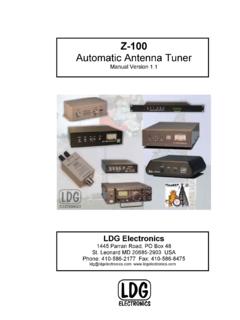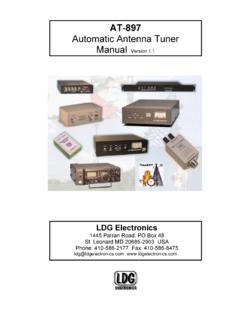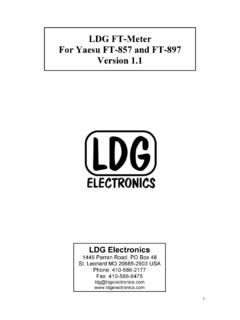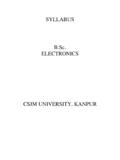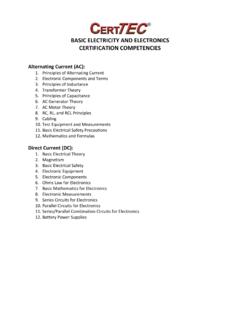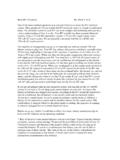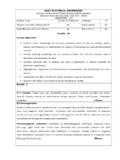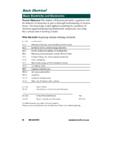Transcription of LDG AT-600Pro 600W Automatic Antenna Tuner
1 AT-600 PRO OPERATIONS MANUAL MANUAL REV A PAGE 1 LDG AT-600 Pro 600w Automatic Antenna Tuner LDG Electronics 1445 Parran Road St. Leonard MD 20685-2903 USA Phone: 410-586-2177 Fax: 410-586-8475 PAGE 2 Table Of Contents Introduction 3 Jumpstart, or Real hams don t read manuals! 3 Specifications 4 An Important Word About Power Levels 4 Important Safety Warning 4 Getting to know your AT-600 Pro 5 Front Panel: 5 Back Panel: 6 Installation 7 BASIC Operation 10 Using the Front Panel Buttons 10 User Configuration Options 10 Transmitting and Receiving 13 Tuning 14 Basic Tuning Operation 14 M anual Memory Tune 14 M anual Full Tune 15 Bypass Mode 16 Error Indication 16 Advanced Operation 18 M anual Inductor/Capacitor Adjustments 18 High/Low Relay Adjustment 18 M anual Memory Store 18 Status Check 19 Application Notes 20 M obile Operation 20 Internally Generated RF Noise 20 M ARS/CAP Coverage 20 Theory of Operation 21 Some basic ideas about impedance 21 Transmitters, transmission lines, antennas.
2 And impedance 21 The LDG AT-600 Pro 23 Quick Reference 24 A Word About Tuning Etiquette 24 Care and Maintenance 25 Technical Support 25 Two-Year Transferrable Warranty 25 Out Of Warranty Service 25 Returning Your Product For Service 26 Product Feedback 26 PAGE 3 INTRODUCTION LDG pioneered the Automatic , wide-range switched-L Tuner in 1995. From its laboratories in St. Leonard, Maryland, LDG continues to define the state of the art in this field with innovative Automatic tuners and related products for every amateur need. Congratulations on selecting the LDG Electronics AT-600 Pro 600-watt Automatic Tuner . The AT-600 Pro provides fully- and semi- Automatic Antenna tuning across the entire HF spectrum plus 6 meters, at power levels up to 600 watts (250W on 6m). It will tune dipoles, verticals, Yagis, or virtually any coax-fed Antenna .
3 It will match an amazing range of antennas and impedances, far greater than some tuners you may have considered, including the built-in tuners on many transceivers. The AT-600 Pro is designed to handle 600 watts of output power, and is ideal for use with small outboard linear amplifiers rated up to 600 watts, or even newer high power transceivers. JUMPSTART, OR REAL HAMS DON T READ M ANUALS! Ok, but at least read this one section before operating the AT-600 Pro: 1. Connect the supplied 50-ohm coax jumper cable from the Antenna jack on your amplifier to the TX jack on the back of the AT-600 Pro. 2. Connect your Antenna s 50-ohm coax feedline to the ANT 2 jack on the rear of the AT-600 Pro. 3. Connect the supplied DC coax cable to the jack marked 12 VDC. Connect this cable to a DC source between 11 and 16 volts DC and at least 750 mA.
4 The jack center tip is positive. 4. Power up the transceiver, and select the desired operating frequency and mode. 5. Bypass the amplifier. Be sure Ant 2 is selected. 6. Begin transmitting, any mode1. 7. When the tuning cycle completes, activate the amplifier, and you re ready to operate! 1 In SS B mo de, si mpl y sp eak in to the mi crophone whi le tran smitting . Tun ing m ay be performed at up to 12 5 wat ts of in put p ower, pro vided th at t he tran sceiver empl oys a ro ll -back cir cuit to prot ect it fr om hi gh SW R. For tr ansceivers wit hout r oll-ba ck cir cuits, power s hould be limited to 25 wat ts when tu ning, to avoid da mag e to th e tr an smitter or tu ner. PAGE 4 SPECIFICATIONS to 600 watt power range (SSB and CW), 250W on 6M. Silver-Teflon SO-239 connectors.
5 Over 4,000 memories for instantaneous band changing. Built- in 2-port Antenna switch, with 2,000 memories each. Tuning time to 15 seconds full tune, seconds memory tune. to MHz coverage. Built- in frequency sensor. Tunes 6 to 800 ohm loads (16 to 150 on 6m), 6 to 3200 ohms with optional 4:1 balun. LED bargraph displays power level, SWR, and status. Antenna Indicator LEDs show the currently selected Antenna . User-selectable operating parameters: Auto/Semi, 125 watt scale, and more. Radio interfaces for ICOM and Yaesu radios included. Power requirements: 11 to 16 VDC @ 750 mA max. Dimensions: x x Weight 3 pounds. AN IMPORTANT WORD ABOUT POWER LEVELS The AT-600 Pro is rated at 600 watts maximum power input at most. Many amplifiers output well over 600 watts.
6 Power levels that significantly exceed specifications will definitely damage or destroy your AT-600 Pro. If the Tuner fails during overload, it could also damage your transmitter, amplifier, or transceiver. Be sure to observe the specified power limitations. IMPORTANT SAFETY WARNING Ne ver install antennas or transmission lines over or near power lines. You can be seriously injured or killed if any part of the Antenna , support, or transmission line touches a power line. Always follow this Antenna safety rule: The distance to the nearest power line should be at leas t twice the length of the longest Antenna , transmission line, or support dimension. PAGE 5 GETTING TO KNOW YOUR AT-600 PRO Your AT-600 Pro is a quality, precision instrument that will give you many years of outstanding service; take a few minutes to get to know it.
7 Front Panel: The front panel of the AT-600 Pro features eight pushbuttons, two LED bargraph scales, and two indicator LEDs: Power: Turns the unit on or off. Func: Activates secondary function of other buttons. Ant: Selects the active Antenna port. C Up: Manually increase capacitance. C Dn: Manually decrease capacitance. L Up: Manually increase inductance. L Dn: Manually decrease inductance. Tune: Initiates memory or full tuning cycle. Momentary push places Tuner in bypass. PWR Meter: Bargraph display indicates forward power in 0-60 and 0-600 watt ranges. SWR M eter: Bargraph display indicates SWR during tuning or transmission. Bypass LED: Lights when the Tuner is in pass-thru mode. ANT 2 LED: Lights when Antenna 2 is selected. Off when Antenna 1 is selected.
8 Each of the pushbuttons has the primary function listed above when pushed. Additionally, pressing the FUNC button before pressing any other button will activate that button s secondary function. PAGE 6 The power button on the AT-600 Pro actually places the Tuner in bypass and enters a low-power sleep mode, rather than turning the unit fully off. Press the Power button for 3 seconds to turn off, or momentarily to turn on. Back Panel: The rear panel of the AT-600 Pro has six jacks. Ant 1: Connect a secondary 50 ohm Antenna coax feedline to this SO-239 connector. Ant 2: Connect the primary 50 ohm Antenna coax feedline to this SO-239 connector. This Antenna port is selected when the DC power is off. Gnd (wing nut): Connect to the Antenna system ground.
9 Tx: Connect a 50 ohm jumper coax from this jack to the ANT jack on the rear of the transceiver. Radio: (optional) Connect the supplied IC-PAC Icom radio interface cable or optional Yaesu interface cable to a supported ICOM or Yaesu radio. Power: Connect the supplied DC coaxial power cable to this connector, and connect to a source of 11-16 VDC with at least 750 mA. Center pin is positive. PAGE 7 INSTALLATION The AT-600 Pro is intended for indoor use only; it is not water-resistant. If you use it outdoors, (Hilltopping expedition, for example) you must protect it from rain. The AT-600 Pro is designed for use with coax-fed antennas. If use with longwires or ladder-line-fed antennas is desired, an external balun rated to 600 watts is required. Place the AT-600 Pro in a convenient location near the transceiver and amplifier.
10 Always turn your radio and amplifier off before plugging or unplugging anything. The radio may be damaged if cables are connected or disconnected while the power is on. Connect the HF Antenna jack on the amplifier to the TX jack on the back of the AT-600 Pro, using the supplied coax jumper cable, or a similar 50 ohm coax cable rated 600 watts or higher. Connect a 50-ohm Antenna feedline coax to the ANT 1 jack on the back of the AT-600 Pro, and optionally connect a second Antenna feedline to the ANT 2 jack. The AT-600 Pro is designed to interface directly with many popular ICOM and Yaesu transceivers, enabling one button tuning. In the case of ICOM radios, the supplied interface cable also powers the Tuner . For ICOM radios supporting the AH-3 or AH-4 external Tuner , connect the 4-pin Molex connector of the supplied ICOM interface cable to the radio s Tuner port.



